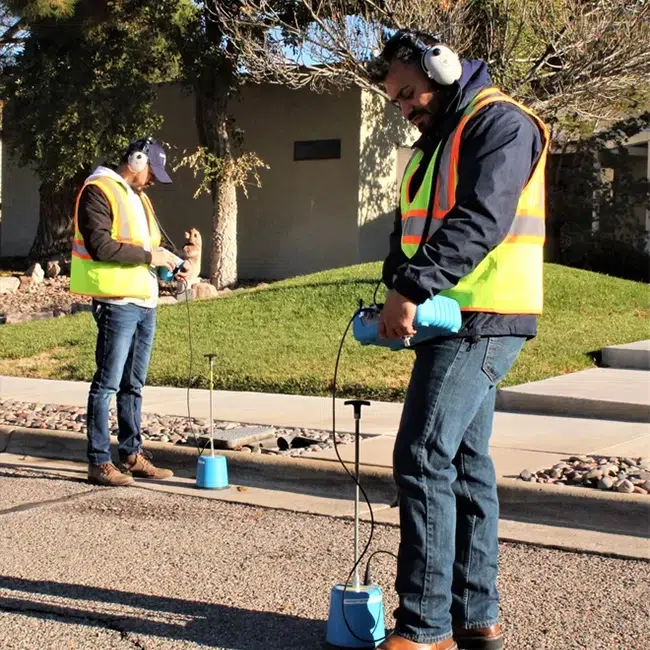Comprehensive Overview to Water Leak Detection for Homeowners and Businesses
Innovative Solutions for Early Detection of Water Leaks in Structures and Infrastructure
From advanced leakage detection technologies to the implementation of IoT sensors for real-time tracking, the landscape of leakage prevention is evolving rapidly. Automated water flow analysis systems are reshaping how leaks are identified and dealt with, paving the way for a proactive technique to water leak detection.
Advanced Leak Discovery Technologies
Advanced leakage discovery modern technologies, outfitted with sophisticated sensing units and formulas, play an essential duty in promptly identifying and pinpointing water leakages in numerous setups. These innovations employ a combination of acoustic, thermal, and electro-magnetic noticing techniques to identify leakages precisely. Acoustic sensors spot the sound of getting away water, permitting for exact localization of the leak resource. Thermal imaging identifies temperature level modifications triggered by water leakage, offering another reliable technique for leak recognition. Electro-magnetic sensors can recognize adjustments in magnetic fields created by water, using yet another layer of leakage discovery ability.

IoT Sensors for Real-Time Surveillance
In the world of modern-day water leak discovery, the integration of IoT sensing units for real-time tracking stands for a pivotal development in improving aggressive leak detection capacities. These sensing units offer continual monitoring of water systems, providing real-time data on water circulation prices, stress variants, and temperature level changes. By leveraging IoT technology, these sensors can discover also the tiniest abnormalities in water use patterns, making it possible for very early recognition of possible leakages prior to they rise right into significant concerns.
IoT sensors transfer data to a centralized platform, where innovative formulas assess the details and produce informs or alerts when abnormalities are identified. This real-time surveillance capacity permits homeowner or facility supervisors to without delay deal with leaks, decreasing water damage, reducing repair costs, and preserving water sources.
Additionally, IoT sensors can be incorporated with structure monitoring systems, permitting automatic reactions to spotted leakages, such as closing off water valves or activating pumps to minimize the impact of leakages. Generally, the application of IoT sensing units for real-time surveillance significantly boosts the effectiveness and effectiveness of water leakage discovery in buildings and framework.
Artificial Intelligence Algorithms for Leakage Prediction

One secret benefit of utilizing device knowing for leak forecast is its ability to continually discover and improve its precision gradually. As more information is accumulated and fed right into the algorithm, it can improve its predictions and adapt to transforming conditions, inevitably boosting the reliability of leakage detection systems.
In addition, artificial intelligence formulas can assist in recognizing refined indications of leaks that might go blog unnoticed by traditional tracking methods. water leak detection. By examining complex information sets in real-time, these algorithms can supply early cautions and alerts, permitting prompt intervention and preventative maintenance to alleviate prospective water Continued damages and associated expenses
Making Use Of Thermal Imaging for Leak Detection
Thermal imaging technology provides an appealing approach for identifying water leakages in numerous systems and infrastructures. By using infrared radiation and temperature level variances, thermal imaging cams can recognize hidden leaks that are not quickly noticeable to the nude eye. When water escapes from pipelines or frameworks, it typically changes the temperature of the bordering location, creating temperature differentials that thermal cameras can record. These temperature irregularities are then converted right into visible images, highlighting the precise location of the leakage.
One of the key benefits of thermal imaging for leak detection is its non-intrusive nature. Unlike conventional techniques that may require breaking right into wall surfaces or floorings to find leaks, thermal imaging enables non-destructive testing. This not only conserves time and lowers prices but also minimizes disruption to the structure or framework being examined. Furthermore, thermal imaging can rapidly scan large locations, offering a thorough introduction of prospective leak resources in a prompt way. In general, making use of thermal imaging technology boosts the effectiveness and accuracy of water leakage discovery, making it an important tool for keeping the stability of buildings and frameworks.
Automated Water Flow Evaluation Solutions
How can automatic water flow evaluation systems revolutionize the discovery and management of leakages in numerous systems and facilities? Automated water flow analysis systems offer a positive approach to leak discovery by constantly monitoring water flow prices and learn this here now patterns. By establishing baseline information, these systems can quickly recognize discrepancies that might indicate a leak, making it possible for prompt intervention to stop comprehensive damage.
These systems make use of sophisticated algorithms to analyze real-time information and give instant informs when anomalies are identified, enabling for speedy activity to be taken. In addition, computerized water circulation evaluation systems can be incorporated with structure monitoring systems or IoT platforms, improving general effectiveness and allowing remote monitoring capacities.
Furthermore, the information accumulated by these systems can be utilized for anticipating maintenance purposes, assisting to determine potential weak factors in the framework prior to leaks happen. On the whole, the execution of computerized water flow analysis systems can considerably improve leakage detection and administration techniques, ultimately leading to cost savings, lowered water wastage, and enhanced sustainability in structures and facilities.

Conclusion
In verdict, the integration of sophisticated leak discovery technologies, IoT sensors, maker knowing algorithms, thermal imaging, and automatic water flow analysis systems uses innovative solutions for early discovery of water leaks in structures and framework. These innovations allow real-time surveillance, forecast of leaks, and effective detection methods to protect against water damage and wastefulness. Executing these remedies can help in preserving the stability and sustainability of water supply in numerous settings.